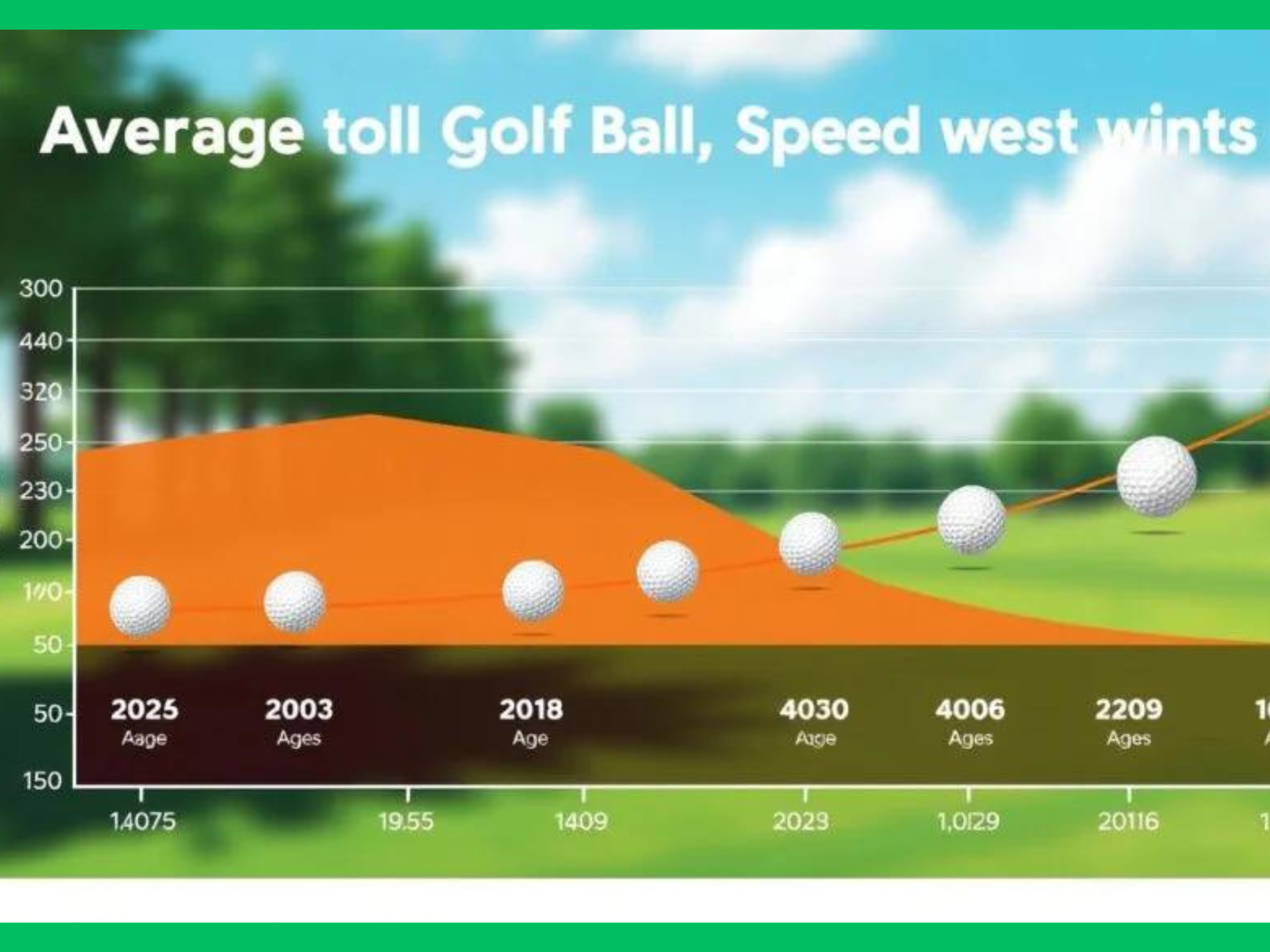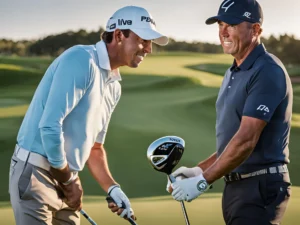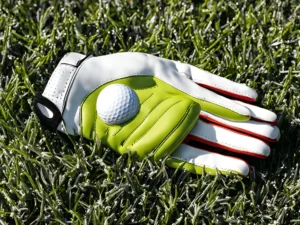Golfers see their ball speed change as they get older. This can affect their driving distance and overall game. Knowing how age impacts ball speed is key for those aiming to improve their game. This article will look at the average ball speed by age, highlighting what affects it and how to keep your swing strong as you age.
Key Takeaways
- Golf ball speed usually goes down with age, especially later in a golfer’s career.
- Swing speed is crucial for ball velocity. Keeping your swing speed up gets harder with age.
- Launch monitor data and trends by age offer insights for golfers to improve their game.
- Smash factor, the ratio of ball speed to swing speed, is key. It helps maximize ball speed, even with age-related changes.
- Using specific techniques and exercises can help golfers of all ages keep their swing speed and ball speed.
Introduction to Golf Ball Speed and Age
Knowing how golf ball speed changes with age is key for all golfers. As we get older, our ball speed often drops. This can affect how far we hit the ball and our overall game.
Looking into why this happens can help us keep playing well as we age. It’s about adapting our game to stay strong and hit the ball far.
Explaining the Correlation Between Age and Ball Speed
As we get older, our bodies change. We lose muscle strength, flexibility, and coordination. This can make our swing slower, which means the ball doesn’t go as far.
The golf ball velocity age trend shows a slow drop in ball speed with age. It’s a natural part of getting older.
Factors Affecting Ball Speed in Golfers of Different Ages
- Muscle strength and power: Losing muscle can make it harder to swing the club fast, leading to lower swing speed age statistics.
- Flexibility and range of motion: Less flexibility in key areas can limit power and age impact on ball speed.
- Reaction time and coordination: Older golfers might find it harder to time their swings right.
- Physiological factors: Changes in bone density, joint health, and physical condition also play a role in ball speed decline.
It’s important for golfers of all ages to understand these factors. This knowledge helps them adjust their training and technique. It keeps their ball speed and distance up as they age.
“As we age, our physical abilities change, and this can have a significant impact on our golf performance. However, with the right strategies and adaptations, golfers can mitigate the effects of age and continue to enjoy the game for many more years.”
Average Golf Ball Speed by Age Ranges
Golf ball speed changes a lot with age. Knowing these changes can help you see how your game might improve or change over time.
In their 20s, golfers usually hit the ball at speeds between 150 to 180 mph. As they hit their 30s, the speed drops a bit, to 140 to 170 mph.
By the 40s, the average speed goes down even more, to 130 to 160 mph. This pattern keeps going into the 50s, where speeds are often 120 to 150 mph.
For those over 60, the average speed is 110 to 140 mph. This slowdown is due to the natural loss of muscle strength and flexibility that comes with aging.
| Age Range | Average Golf Ball Speed (mph) |
|---|---|
| 20s | 150 – 180 |
| 30s | 140 – 170 |
| 40s | 130 – 160 |
| 50s | 120 – 150 |
| 60+ | 110 – 140 |
Knowing these average golf ball speed by age trends helps golfers of all ages. It lets them see how they stack up and find ways to get better. By understanding ball speed trends age and ball speed demographics, players can work on keeping or boosting their drive as they age.
The Role of Swing Speed in Ball Velocity
To grasp how age affects golf ball speed, we must look at swing speed and ball velocity. Swing speed is how fast a golfer’s club head moves at impact. As people age, keeping up this speed becomes harder, which can lower ball speed and driving distance.
Techniques to Maintain Swing Speed as You Age
There are ways to keep your swing speed up as you get older. These include improving flexibility, building muscle strength, and fine-tuning your swing. Let’s dive into some effective methods:
- Flexibility Training: Regular stretching and mobility exercises help keep your swing strong. Try dynamic stretches, yoga, and specific drills to boost your range of motion.
- Strength Training: Keeping your muscles, especially in the core, hips, and shoulders, strong is key. Use free weights or resistance bands to build power.
- Swing Technique Refinement: A golf instructor can help you improve your swing mechanics. Focus on weight transfer, club head path, and impact position to boost speed and efficiency.
- Club Fitting: Make sure your clubs fit your current swing and physical abilities. Regular fittings can help you find the right equipment for your game.
By using these techniques, golfers can keep their swing speed and ball speed as they age. This helps them keep their driving distance and overall game performance longer.
Average Golf Ball Speed by Age: What the Data Shows
Age is a big factor in golf ball speed. By looking at data from golf launch monitors, we learn a lot. This helps us understand how ball speeds change with age.
Golfers in their 20s and 30s usually hit the ball the fastest. Their speeds range from 155 to 165 mph. As they get older, into their 40s and 50s, their speeds start to drop. They average around 145-155 mph.
The biggest drop in speed happens after 60. Golfers in this age group might hit the ball at 135-145 mph. This is a big difference from when they were younger.
| Age Range | Average Ball Speed (mph) |
|---|---|
| 20s | 160 |
| 30s | 165 |
| 40s | 155 |
| 50s | 150 |
| 60+ | 140 |
These age-related ball speed trends are very useful. They show how golf launch monitor data and age-related ball speed analysis help golfers. They can learn to keep their speed up as they get older.

“Maintaining ball speed is crucial for golfers of all ages, as it directly impacts their driving distance and overall performance on the course.”
Understanding the Impact of Age on Ball Speed
As golfers get older, they often see their ball speed drop. This happens due to changes in the body over time. Knowing how age affects ball speed is key for golfers to keep their distance and performance up.
Loss of muscle mass and flexibility are big reasons for the drop in ball speed with age. Our muscles get less efficient as we age, losing power and explosiveness. This makes our swing speed go down, which then lowers the ball speed.
Another factor is the decrease in joint mobility and flexibility. Our joints get stiffer with age, limiting our swing’s power and range. This makes it harder for older golfers to hit the ball with the right speed and direction.
- Decreased muscle mass and power
- Reduced joint mobility and flexibility
- Slower reaction times and decreased coordination
Age also affects reaction times and coordination, making the swing harder to time. These changes can lead to a noticeable drop in ball speed as golfers get older.
It’s important for golfers to understand how age affects ball speed. By knowing this, they can work on their swing and training to keep their distance and performance up.
Launch Monitor Data and Age-Related Ball Speed Trends
Golf launch monitors give us a peek into how age affects ball speed. They help us see how our game might change as we get older. This knowledge helps us make better choices for our game.
Research shows that ball speed often drops with age. This is due to weaker muscles, less flexibility, and a decline in physical health. But, how fast this happens can differ from person to person. It depends on fitness, swing style, and health.
| Age Range | Average Ball Speed (mph) |
|---|---|
| 20-29 years | 155 |
| 30-39 years | 150 |
| 40-49 years | 145 |
| 50-59 years | 140 |
| 60-69 years | 135 |
| 70+ years | 130 |
Launch monitor data helps us understand typical ball speed changes with age. By tracking our own ball speed, we can spot areas to improve. This way, we can keep our power and distance as we age.

Launch monitors also reveal insights into other age-related factors. These include launch angle, spin rate, and carry distance. By looking at all this data, we can make smarter choices about our equipment and swing.
Smash Factor: Analyzing the Age Factor
For golfers, knowing about smash factor is key to boosting ball speed, no matter their age. Smash factor is the ball speed divided by club head speed. It helps show how age affects golf skills.
Optimizing Smash Factor for Maximum Ball Speed
As golfers get older, keeping a high smash factor is vital. It helps counteract the drop in club head speed. Older golfers can keep their ball speed up by focusing on their smash factor.
Here are tips for all ages to boost their smash factor:
- Improve club head speed through strength training and swing mechanics
- Ensure proper club fitting and loft adjustment to match their swing characteristics
- Develop a consistent, efficient swing to maximize energy transfer to the ball
- Experiment with equipment and ball combinations to find the optimal smash factor age and age impact on ball speed
“Maintaining a high smash factor is the key to preserving ball speed as you age. With the right techniques and equipment, golfers can offset the natural decline in club head speed and keep their drives long and accurate.”
Understanding the link between smash factor age and age impact on ball speed helps golfers. They can adjust their game to stay competitive, no matter their age.
Age and Driving Distance: The Ball Speed Connection
As golfers get older, their ball speed often goes down. This can really affect how far they can hit the ball. It’s important to understand how age, ball speed, and distance are connected for better golf performance.
Studies have found that golfers hit the ball shorter as they age. This drop in distance mainly comes from slower ball speed. As we get older, our muscles get weaker, less flexible, and we swing the club slower.
But, golfers can fight back against age’s effects. They can work on keeping their swing speed up through training and adjusting their clubs. Knowing how age affects ball speed and distance helps golfers make better choices about their gear and strategy as they get older.
FAQ
What is the average golf ball speed by age?
Golf ball speed goes down as people get older. Younger players in their 20s hit the ball at 160-170 mph. But, those in their 60s and older hit it at 130-140 mph.
How does swing speed change with age?
Swing speed drops with age. This is because of less muscle strength, flexibility, and physical ability. Golfers lose about 1-2 mph in swing speed every decade.
What is the impact of age on ball speed and driving distance?
Older golfers hit the ball shorter distances. This is because their club head speed and ball velocity go down. They might lose 10-20 yards in driving distance over time.
How can golfers maintain their ball speed as they age?
To keep ball speed up, golfers should do strength training, flexibility exercises, and work on their swing. These steps help counteract the natural decline in physical abilities and keep ball speed higher for longer.
What does golf launch monitor data show about age-related ball speed trends?
Launch monitor data shows ball speed goes down with age, especially after 50. But, those who stay fit and work on their swing can keep their ball speed higher than others.
How does smash factor change with age?
Smash factor, the ratio of ball speed to club head speed, goes down with age. This is because club head speed drops more than ball speed. Working on smash factor can help older golfers hit the ball farther.
Related More:
- Understanding E-Z-Go Golf Cart Transmission Problems: Causes and Solutions
- Understanding Why Your Golf Cart Runs with the Key Off: A Troubleshooting Guide
- Golf Ball Bags: Combining Convenience and Style
- Golf Ball Markers: The Small Equipment with a Big Impact on Your Game
- Srixon Golf Balls: Revealing the Hidden Gems You Need to Know
- Fairway Revolution: The Hidden Power of Golf Ball Retrievers
- The Golf Ball Grinder: A Unique Tool for Every Golf Enthusiast
- The Art of Display: Creating the Perfect Golf Ball Display Case
- Vice Golf Balls Review: Performance, Quality, and Value Explored
- The Golf Ball Slide Mastery: Expert Tips for Optimal Control
- 2024: The Journey of Lost Golf Balls – Beyond the Fairway
- The Average Age of Golfers In Depth Look 2024
- Golf Club Selection Tips to Help You Choose the Right Club




